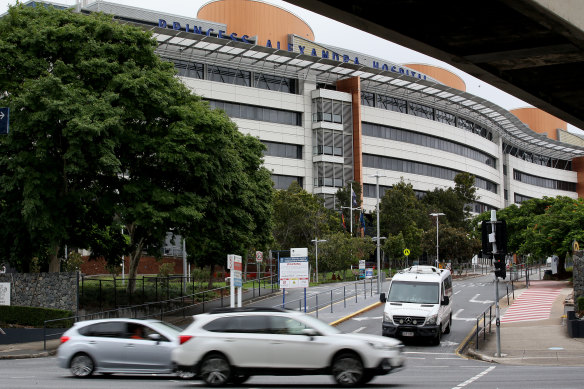This was published 3 years ago
Queensland hospitals divert patients as COVID crunches capacity
By Matt Dennien
Hospitals across Queensland have been forced to divert sick and injured people to other sites due to capacity issues as the state battles its Omicron-driven coronavirus wave.
The detail comes as all but two of the state’s public health regions are revealed to be treating COVID patients in their hospitals, with 850 people now admitted in wards — including 48 in intensive care units.

Queensland reported nine COVID deaths and 16,812 new known infections on Thursday.Credit: Jono Searle/Getty
Data provided to Brisbane Times showed Queensland public hospitals have already declared 12 capacity code yellows between January 1 and January 19. At least 14 were declared statewide across December.
Five of the January code yellow events were declared at sites in the Wide Bay Health and Hospital Service area alone. Two were declared in Mackay, with the remaining five across the Gold Coast, Metro South, West Moreton, Townsville and North West regions.
The events are declared when capacity is constrained to the point that a whole-of-hospital response is needed, including managing admissions via the emergency departments and ambulances. Data for central Queensland and Metro North was not available at the time of publishing.
In a statement, a Queensland Health spokeswoman said public hospitals were seeing more patients than ever and anyone who attended a facility would be treated, prioritising those who need the most urgent care first.
“A code yellow is not cause for alarm in the community — it is an internal activation which allows our hospitals to allocate resources,” she said.
Chief Health Officer John Gerrard revealed on Thursday authorities were planning for COVID patients in the “low thousands” across hospitals at the wave’s peak expected by early February.
Some other patients have been shifted into the private sector, while sites have already used tents to triage new patients in a safe waiting area to avoid congestion inside.
This includes on the hard-hit Gold Coast, where seven wards alone were dedicated to 188 patients across its two major hospitals as of Wednesday night, with more to be allocated ahead of a regional peak there within days.
The health service region has the state’s largest percentage of total patients and shares the highest portion of the 48 in ICUs, at 13, with Metro North.
Authorities believe Brisbane will be the next to experience the full surge soon after, as the virus fans out deeper into communities across the state. The Gold Coast and Cairns have been reporting the highest per-capita infections rates this week.
Australian Medical Association Queensland president Chris Perry said while intensive care units were largely coping so far the situation was “really quite grim” in hospitals as many experienced the virus for the first time.
Until December, when the public health order was revoked as the state relaxed domestic borders and prepared for the widespread outbreak, only a handful of the state’s largest public hospitals managed COVID-positive patients in a dedicated network.
Australasian College for Emergency Medicine president Clare Skinner said the shift for emergency departments in the state had been swift and challenging from their prior largely virus-free status.
This was exacerbated by the surge during the Christmas and New Year’s Even period — one of the busiest times of the year for the departments. Staff shortages being felt across Australia were also having an impact.
“There are simply not enough community care pathways for the sheer amount of people being infected,” Dr Skinner said. “Emergency departments are sometimes the only option for people to turn to when they need care, or health advice on managing COVID-19.”
While NSW authorities expect hospital figures to peak this week below best-case predictions, the Victorian government has announced a statewide code brown to relieve pressure on the hospital system.
Queensland officials have urged people to only dial triple zero or make their way to hospital if experiencing severe symptoms of the virus such as difficulty breathing or ongoing chest pain.
The Morning Edition newsletter is your guide to the day’s most important and interesting stories, analysis and insights. Sign up here.